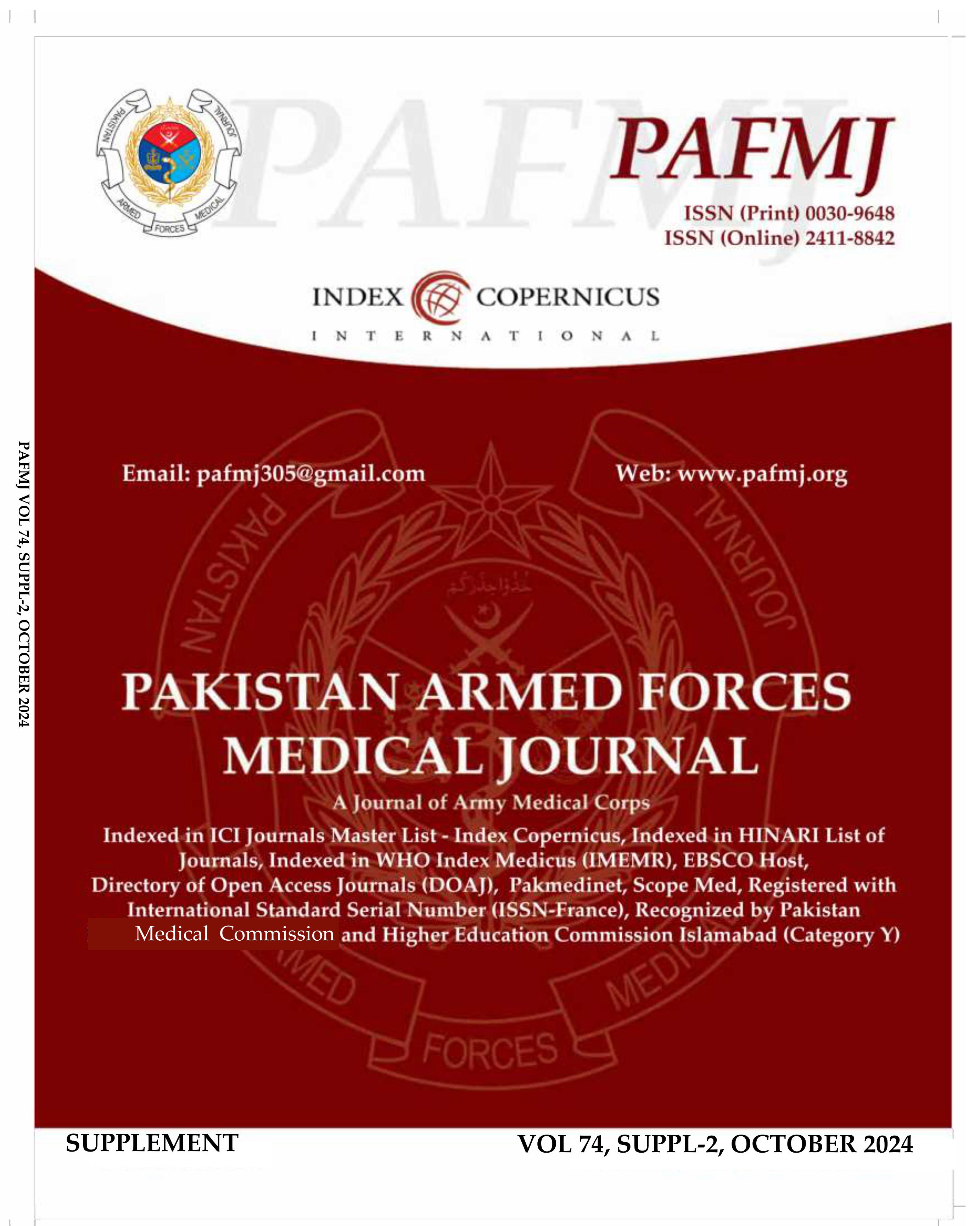Comparison of Onlay Mesh Repair Vs Sublay Mesh Repair for Ventral Abdominal Hernias: A Focus on Post Op Seroma Formation
DOI:
https://doi.org/10.51253/pafmj.v74iSUPPL-2.5989Keywords:
Onlay mesh, Sublay mesh, Seroma formation, Ventral abdominal hernia.Abstract
Objective: To compare the effectiveness of Onlay mesh repair versus Sublay mesh repair for ventral abdominal hernias in terms of post op seroma formation.
Study Design: Quasi-experimental study.
Place and Duration of Study: Department of General Surgery, Pak Emirates Military Hospital, Rawalpindi Pakistan, from Feb to Sep 2020.
Methodolgy: A total of 140 patients (70 in each group) of ventral abdominal hernia who met the inclusion and exclusion criteria were included in the study. Patients with complicated or recurrent hernias were excluded. Group-A patients underwent Onlay hernioplasty while in group B hernioplasty was performed via Sublay technique. All patients were followed for post op seroma formation till 2 weeks via ultrasonography. Data was analyzed by Statistical Package for Social Sciences version 22.
Results: Mean operation time in Group-A was 52.30±6.65 minutes while in Group-B the mean operation time was 85.82±8.26 minutes. Post op seroma formation between the two groups was 18.10% vs 4.65%, which was statistically significant (p=0.023).
Conclusion: The occurrence of Post op seroma formation is less in Sublay lay mesh repair as compare to Onlay mesh repair however it requires longer operative time.
Downloads
References
Godara R, Garg P, Raj H, Singla SL. Comparative evaluation of" Sublay" versus" Onlay" meshplasty in ventral hernias. Indian J Gastroenterol 2006; 25(4): 222-223.
Cherla DV, Poulose B, Prabhu AS. Epidemiology and Disparities in Care: The Impact of Socioeconomic Status, Gender, and Race on the Presentation, Management, and Outcomes of Patients Undergoing Ventral Hernia Repair. Surg Clin North Am 2018 Jun; 98(3): 431-440.
Zavlin D, Jubbal KT, Van Eps JL, Bass BL, Ellsworth WAt, Echo A, et al. Safety of open ventral hernia repair in high-risk patients with metabolic syndrome: a multi-institutional analysis of 39,118 cases. Surg Obes Relat Dis 2018 Feb; 14(2): 206-213.
Tandon A, Shahzad K, Pathak S, Oommen C, Nunes Q, Smart N. Parietex™ Composite mesh versus DynaMesh®-IPOM for laparoscopic incisional and ventral hernia repair: a retrospective cohort study. Ann R Coll Surg Engl 2016; 98(8): 568-573.
Tandon A, Pathak S, Lyons NJ, Nunes QM, Daniels IR, Smart NJ. M etaanalysis of closure of the fascial defect during laparoscopic incisional and ventral hernia repair. BJS Open 2016 Nov; 103(12):1598-1607.
Huntington CR, Cox TC, Blair LJ, Schell S, Randolph D, Prasad T, et al. Biologic mesh in ventral hernia repair: Outcomes, recurrence, and charge analysis. Surgery 2016; 160(6): 1517-1527.
Heniford BT, Ross SW, Wormer BA, Walters AL, Lincourt AE, Colavita PD, et al. Preperitoneal Ventral Hernia Repair: A Decade Long Prospective Observational Study With Analysis of 1023 Patient Outcomes. Ann Surg Open 2020; 271(2): 364.
Gonzalez A, Escobar E, Romero R, Walker G, Mejias J, Gallas M, et al. Robotic-assisted ventral hernia repair: a multicenter evaluation of clinical outcomes. Surg. Endosc 2017; 31(3): 1342-1349.
Talebpour M, Khatami F, Aghaii M, Aghamir SMK. New technique of inguinal hernia repair during prostatectomy. J Clin Urol 2020: 2051415820961301.
Dhaigude B, Sugunan A, Pancbhai S, Francis M, Patel K, Metta V. Comparative evaluation of Sublay versus Onlay meshplasty in incisional and ventral hernias. Int Surg J 2017; 5(1): 187-192.
Ibrahim, T., Ahmed, W., Ahmed, I., Mushtaq, K., Hussain, A., & Ahmed, N. (2018). Comparison of onlay versus sublay mesh repair for ventral abdominal hernias. A randomized controlled trial. Pak Armed Forces Med J 68(6): 1700-1704.
Haskins IN, Voeller GR, Stoikes NF, Webb DL, Chandler RG, Phillips S, et al. Onlay with Adhesive Use Compared with Sublay Mesh Placement in Ventral Hernia Repair: Was Chevrel Right? J Am Coll Surg 2017; 224(5): 962-970.
Sevinç B, Okuş A, Ay S, Aksoy N, Karahan Ö. Randomized prospective comparison of long-term results of Onlay and Sublay mesh repair techniques for incisional hernia. Turk J Surg 2018; 34(1): 17-20.
Raghuveer M, Muralidhar S, Shetty H, Veena V. Onlay versus Sublay mesh repair for ventral hernia. Int Surg J 2018; 5(3): 823-826.
Pawlak M, Bury K, Śmietański M. The management of abdominal wall hernias–in search of consensus. Wideochir Inne Tech Maloinwazyjne 2015; 10(1): 49.
Schroeder AD, Debus ES, Schroeder M, Reinpold WMJ. Laparoscopic transperitoneal Sublay mesh repair: a new technique for the cure of ventral and incisional hernias. Surg. Endosc 2013; 27(2): 648-654.
Ahonen-Siirtola M, Vironen J, Mäkelä J, Paajanen H. Surgery-related complications of ventral hernia reported to the Finnish Patient Insurance Centre. Scand J Surg 2015; 104(2): 66-71.
Bates AT, Divino C. Laparoscopic surgery in the elderly: a review of the literature. Aging Dis 2015; 6(2): 149.
Jairam AP, Timmermans L, Eker HH, Pierik REGJM, van Klaveren D, Steyerberg EW, et al. Prevention of incisional hernia with prophylactic Onlay and Sublay mesh reinforcement versus
Downloads
Published
Issue
Section
License
Copyright (c) 2024 Fahim Liaqat, Muhammad Qasim Butt, Usman Ghani, Mansoor Tariq Azeem, Muhammad Shoaib Khan, Tayyaba Mushtaq Khan

This work is licensed under a Creative Commons Attribution-NonCommercial 4.0 International License.















